一、JSR107
Java Caching定义了5个核心接口,分别是CachingProvider, CacheManager, Cache, Entry 和 Expiry。
1、CachingProvider定义了创建、配置、获取、管理和控制多个CacheManager。
一个应用可以在运行期访问多个CachingProvider。
2、CacheManager定义了创建、配置、获取、管理和控制多个唯一命名的Cache,
这些Cache存在于CacheManager的上下文中。一个CacheManager仅被一个CachingProvider所拥有。
3、Cache是一个类似Map的数据结构并临时存储以Key为索引的值。一个Cache仅被一个CacheManager所拥有。
4、Entry是一个存储在Cache中的key-value对。
5、 Expiry 每一个存储在Cache中的条目有一个定义的有效期。一旦超过这个时间,条目为过期的状态。
一旦过期,条目将不可访问、更新和删除。缓存有效期可以通过ExpiryPolicy设置。
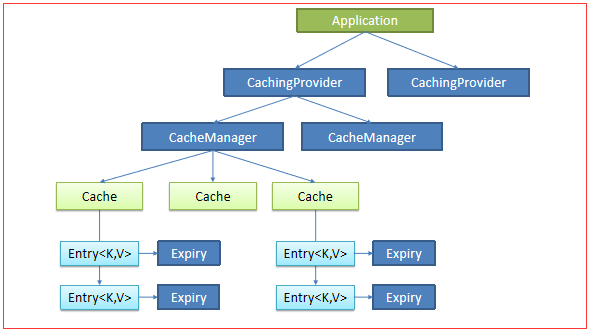
使用比较麻烦
二、Spring缓存抽象
Spring从3.1开始定义了
org.springframework.cache.Cache
和org.springframework.cache.
CacheManager接口来统一不同的缓存技术;
并支持使用
JCache(JSR-107)注解简化我们开发;
Cache接口为缓存的组件规范定义,包含缓存的各种操作集合;
Cache接口下Spring提供了各种xxxCache的实现;
如RedisCache,EhCacheCache , ConcurrentMapCache等;
每次调用需要缓存功能的方法时,Spring会检查检查指定参数的指定的目标方法是否已经被调用过;
如果有就直接从缓存中获取方法调用后的结果,如果没有就调用方法并缓存结果后返回给用户。
下次调用直接从缓存中获取。
使用Spring缓存抽象时我们需要关注以下两点;
1、确定方法需要被缓存以及他们的缓存策略
2、从缓存中读取之前缓存存储的数据
基本环境搭建:
代码实践讲解:
新建工程:
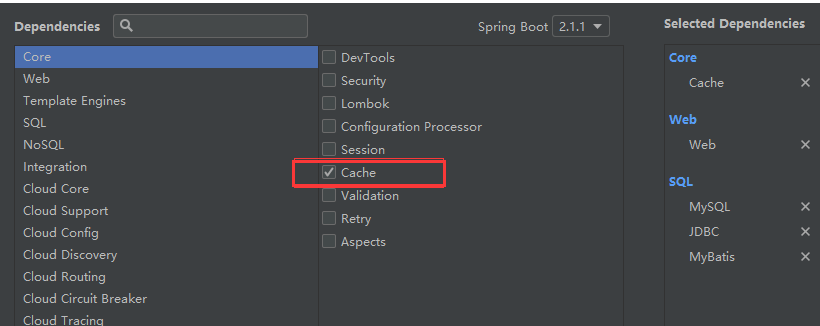
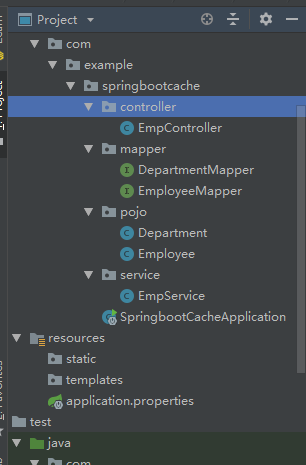
public class Department { private Integer id; private String departmentName; ...}
public class Employee { private Integer id; private String lastName; private String email; private Integer gender; //性别 1男 0女 private Integer dId; ...}
public interface EmployeeMapper { @Select("SELECT * FROM employee WHERE id = #{id}") Employee getEmpById(Integer id); @Update("UPDATE employee SET lastName=#{lastName},email=#{email},gender=#{gender},d_id=#{dId} WHERE id=#{id}") public void updateEmp(Employee employee); @Delete("DELETE FROM employee WHERE id=#{id}") public void deleteEmpById(Integer id); @Insert("INSERT INTO employee(lastName,email,gender,d_id) VALUES(#{lastName},#{email},#{gender},#{dId})") public void insertEmployee(Employee employee); @Select("SELECT * FROM employee WHERE lastName = #{lastName}") Employee getEmpByLastName(String lastName); }
@Service public class EmpService { @Autowired EmployeeMapper employeeMapper; public Employee getEmp(Integer id){ System.out.println("查询:" + id +"员工"); Employee emp = employeeMapper.getEmpById(id); return emp; } }
@Controller public class EmpController { @Autowired EmpService empService; @ResponseBody @RequestMapping("/emp/{id}") public Employee getEmp(@PathVariable("id")Integer id){ Employee emp = empService.getEmp(id); return emp; } }

测试:

使用缓存:
1.开启基于注解的缓存 @EnableCaching
2.标注缓存即可
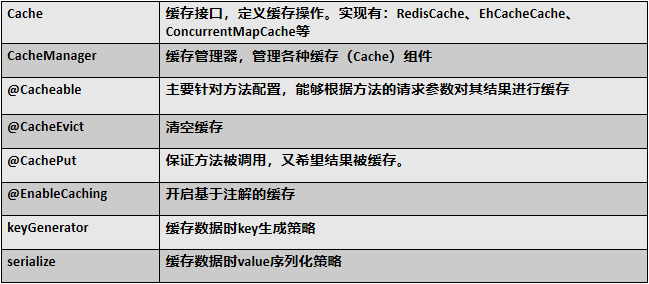
在主程序中:开启缓存
@MapperScan("com.example.springbootcache.mapper") @SpringBootApplication @EnableCaching public class SpringbootCacheApplication { public static void main(String[] args) { SpringApplication.run(SpringbootCacheApplication.class, args); } }
此时页面连续请求两次:

控制台会打印两次,具体看EmpService类的查询方法

@Cacheable public Employee getEmp(Integer id){ System.out.println("查询:" + id +"员工"); Employee emp = employeeMapper.getEmpById(id); return emp; }
@Cacheable:将方法运行的结果进行缓存,之后在要相同的数据,直接从缓存中取,不在调用方法
属性:
CacheManager管理多個Cache組件的,對緩存的真正CRUD操作在Cache組件中,每一個緩存組件有自己唯一一個名字;
幾個屬性:
cacheName/value:指定緩存組件的名字;將方法的返回結果放在哪個緩存中是數組的方式,可以指定多個緩存
key:緩存數據使用的key;可以用它來指定。默認是使用方法的參數 1-方法的返回值
編寫SpEl; #id;參數id的值 #a0 #p0 #root.args[0]
keyGenerator: key的生成器: 可以指定key的生成器的組件id
key/keyGenerator: 二選一使用
key = "#root.methodName + '['+id+']'"
cacheManager: 指定緩存管理器;或者cacheResolver指定獲取解析器
condition: 指定符合條件的情況下才緩存
condition = "#id>0"
condition = "#a0>1" 第一個參數>1的情況下進行緩存
unless: 否定緩存;當ubless指定的條件爲true,方法的返回值就不會被緩存;可以獲取到結果進行判斷
unless = "#result == null"
#result爲方法的返回值
sync:是否使用異步緩存
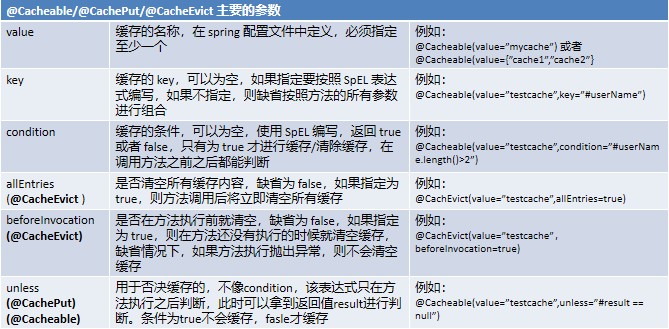

@Cacheable(cacheNames ="e" ) public Employee getEmp(Integer id){ System.out.println("查询:" + id +"员工"); Employee emp = employeeMapper.getEmpById(id); return emp; }
此时刷新很多遍依然只打印一次

三、缓存原理

@Configuration @ConditionalOnClass({CacheManager.class}) @ConditionalOnBean({CacheAspectSupport.class}) @ConditionalOnMissingBean( value = {CacheManager.class}, name = {"cacheResolver"} ) @EnableConfigurationProperties({CacheProperties.class}) @AutoConfigureAfter({CouchbaseAutoConfiguration.class, HazelcastAutoConfiguration.class, HibernateJpaAutoConfiguration.class, RedisAutoConfiguration.class}) //给容器导入一些组件 @Import({CacheAutoConfiguration.CacheConfigurationImportSelector.class}) public class CacheAutoConfiguration { ... public String[] selectImports(AnnotationMetadata importingClassMetadata) { CacheType[] types = CacheType.values(); String[] imports = new String[types.length]; for(int i = 0; i < types.length; ++i) { imports[i] = CacheConfigurations.getConfigurationClass(types[i]); } return imports; } } }
public String[] selectImports(AnnotationMetadata importingClassMetadata)中的return imports;
会给容器导入10个配置类

在配置文件中:判断那个缓存是生效的
debug=true

由图可知是SimpleCacheConfiguration 缓存类

@Configuration @ConditionalOnMissingBean({CacheManager.class}) @Conditional({CacheCondition.class}) class SimpleCacheConfiguration { private final CacheProperties cacheProperties; private final CacheManagerCustomizers customizerInvoker; SimpleCacheConfiguration(CacheProperties cacheProperties, CacheManagerCustomizers customizerInvoker) { this.cacheProperties = cacheProperties; this.customizerInvoker = customizerInvoker; } @Bean public ConcurrentMapCacheManager cacheManager() { ConcurrentMapCacheManager cacheManager = new ConcurrentMapCacheManager(); List<String> cacheNames = this.cacheProperties.getCacheNames(); if (!cacheNames.isEmpty()) { cacheManager.setCacheNames(cacheNames); } return (ConcurrentMapCacheManager)this.customizerInvoker.customize(cacheManager); } }
给容器中注册了一个缓存管理器
ConcurrentMapCacheManager可以获取和创建

@Nullable public Cache getCache(String name) { Cache cache = (Cache)this.cacheMap.get(name); if (cache == null && this.dynamic) { ConcurrentMap var3 = this.cacheMap; synchronized(this.cacheMap) { cache = (Cache)this.cacheMap.get(name); if (cache == null) { cache = this.createConcurrentMapCache(name); this.cacheMap.put(name, cache); } } } return cache; }
按照名字取获取,如果为空则会创建一个缓存
运行流程:
@Cacheable
1.方法运行之前先去查询缓存组件,按照Cache的name取获取(CacheManager先获取相应的缓存)
第一次获取缓存没有则会自动创建
2.取Cache中查找缓存,使用以可key,默认就是方法的参数
key是按照某种策略生成的,默认使用keyGenerator,默认使用SimpleKeyGenerator

3.没有查到缓存就调用目标方法
4.将目标方法返回的结果放入缓存中
@Cacheable标注的方法执行之前先来检查缓存中有没有这个数据,
默认按照参数的值作为key取查询缓存
如果没有就运行方法并且将结果放入缓存

其属性的使用:
key:数据库使用的key

此时的key就是 方法名+id; 即 getEmp[1]
keyGenerator:
指定key
@Configuration public class MyConfig { @Bean("MyKeyGenerator") public KeyGenerator keyGenerator(){ return new KeyGenerator() { @Override public Object generate(Object o, Method method, Object... objects) { //Objects事获得其输入的cache中的属性值 return method.getName() +"[" + Arrays.asList(objects).toString()+"]"; } }; } }

断点位置:

可以看到debug进入时的值: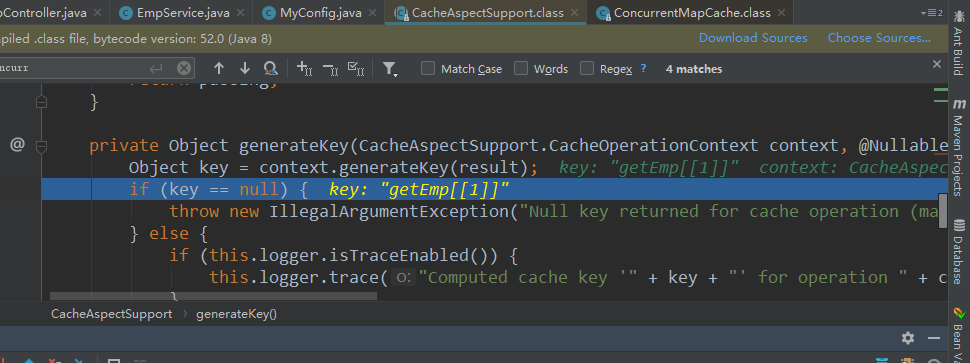
cacheManager:指定缓存管理器
condition:

@Cacheable(cacheNames ="e", keyGenerator = "MyKeyGenerator",condition = "#a0>1")
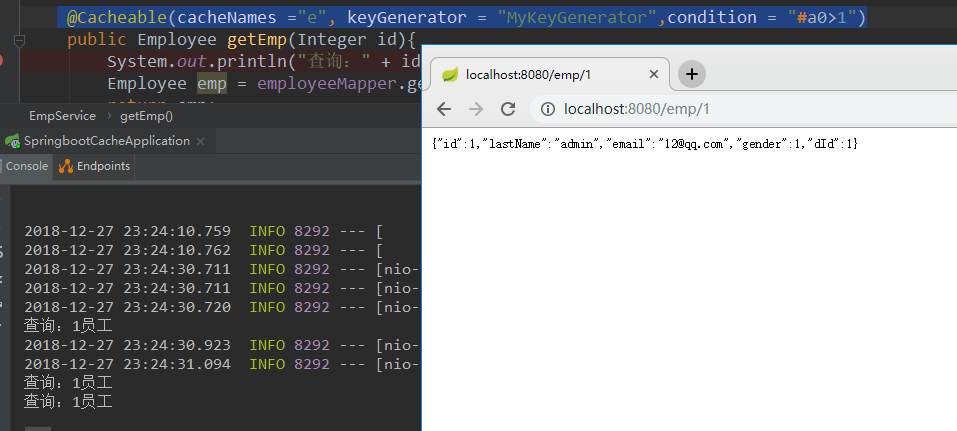
此时查询一次打印一次
